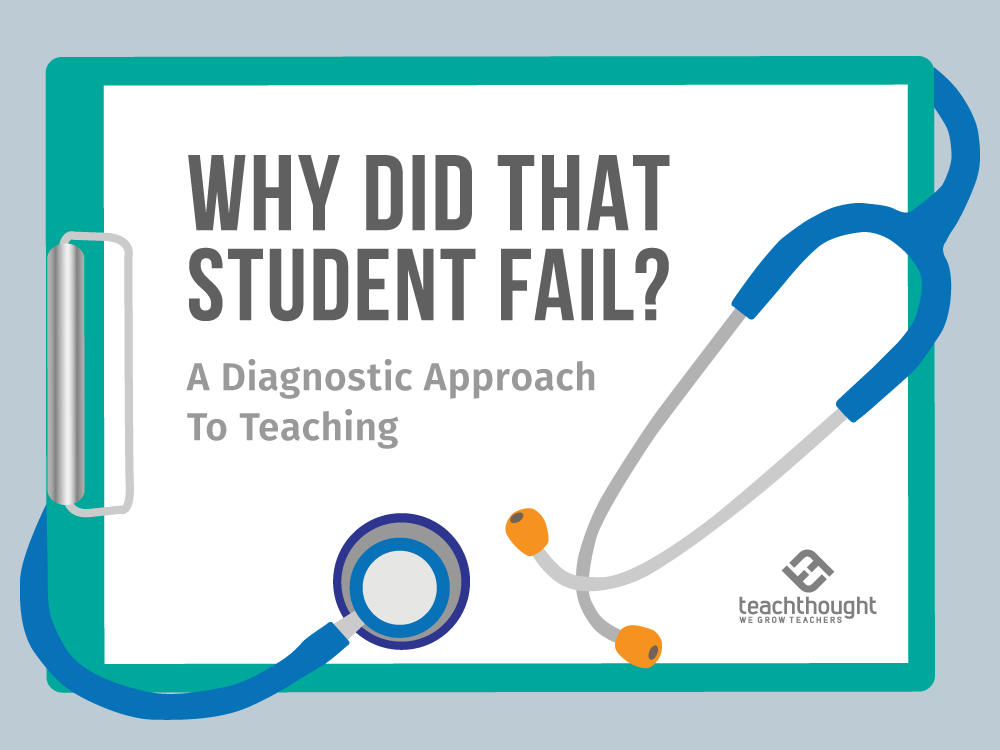Why Did That Student Fail? A Diagnostic Approach To Teaching
by Terry Heick
When students struggle in school, it can be for a variety of reasons.
From their grasp of content and literacy skills to their engagement level to behavior and organizational issues, to teacher actions, to the proverbial ‘stuff going on at home,’ the possibilities are maddeningly endless. The following 8-step process is a valuable tool for me as a teacher, so I thought I’d share a version of it here in hopes that it might help you. It was useful not only for me to see what strategic responses I had available to me as a teacher, but it was also useful for students to come to know what to expect.
It also was valuable in teacher conferences, and in discussions with district folks during walk-throughs when they wanted to know how I ‘responded to non-mastery’ (beyond reteach the same content in the same broken form with the same ineffective strategies that failed the first time.)
As you can see in the image below, this functions as a kind of hierarchy. The first step is the broadest and most powerful and worked for the largest number of students. The second step is a bit more narrow and wasn’t necessary nearly as often as step 1, and so on until step 8 which was necessary for very few students. This model worked effectively in grades 8-12, though I have never used it in elementary.
See Also 25 Self-Guided Reading Responses for Fiction and Non-Fiction
The Goal Of Diagnostic Teaching
It is important to keep in mind the goal of this process–diagnosis. What’s wrong? What’s the hang-up? What’s getting in the way of learning, or of students proving what they in fact actually know?
No matter what process, model, system, or flowchart you use, as long as you have something designed and documented, you can use and refine it accordingly, keeping you from knee-jerk reactions to non-mastery like repeating yourself, talking louder/faster/slower, holding students after class, calling home, issuing poor grades, having them partner with ‘good students,’ giving them the majority of the answer, and so on.
Diagnostic Teaching: An 8-Step Process To Support Struggling Students
1. Fundamental curricular & unit design
In diagnostic teaching, your first response should also be your broadest and most powerful. In this case, that is how you design your curriculum and instruction map by map, unit by unit, lesson by lesson. Within each of these pieces should be built-in devices to automatically–without any action on your part–respond to students that struggle.
In short, spiral big ideas and power standards continuously throughout the year so students have access to the learning targets and standards a half-dozen or more times, in a variety of guises and forms. Provided students read somewhere near grade level and complete the majority of their work–and that work is within their Zone of Proximal Development–this can be incredibly effective all by itself.
To accomplish this, consider an approach to curriculum mapping and instructional design that prioritizes. Power standards, spiraling, transfer, and Bloom’s Taxonomy are all tremendously useful in teaching and learning. The school year is a marathon, not a series of curricular sprints. You have the students for approaching an entire calendar year. Design learning experiences around a handful of ‘big ideas’ and power standards that were practiced over and over again and various levels of ‘cognitive intensity.’
Whether you use Bloom’s Taxonomy, Depth of Knowledge, the TeachThought Taxonomy, or any other, the idea is to be able to scaffold and frame instruction for a diverse set of learners would work. Obviously this concept probably deserves a post of its own, but in general if students don’t ‘master’ a standard (or learning objective) in November, that was okay because they’ll likely see it again in December, February, and April as well.
Summary
In short, map curriculum and design units in a way that pre-emptively plans for struggling students from the very beginning. If this isn’t enough as you diagnose the problem? On to step 2.
2. Complete all missing or incomplete assignments
The next step in Diagnostic Teaching has to do with individual assignments. If students don’t complete the work–the ‘practice’–they can’t improve. This means all graded work (not everything was graded) would need to be revised until it reflected ‘mastery.’ Again, this is a whole post in and of itself–what is mastery, what do we accept as evidence, etc.
The idea, though, is for every student to complete every assignment. If they did not or could not complete the work, You need to know which it was–couldn’t or didn’t. Once you know, you can respond more accurately.
If they just didn’t–well, the next step is obvious. Do it.
If they couldn’t? Your next step would is to clarify the instructions–make sure their poor performance isn’t a matter of not understanding what the assignment is asking them to do. If relevant, you can also emphasize any rubrics–make sure they saw it, read it, and could make sense of it.
Just as above–if not, I’d clarify; if they’re confused, revise the rubric so that it ‘meets them where they are’–right there in front of them with a pen so that you both are on the same page. If this isn’t enough to diagnose the problem, and the issue is correctable without major changes, you can contact home for help with the assignment and rubric. (Note–be careful here. Be specific with exactly why you’re calling home; you don’t want student ‘in trouble’ when they simply need help.)
Summary
The big ideas here are completion and clarity. Students either need to finish the work so you can diagnose, or you need to clarify what to do and why so they can indeed finish it.
Mark non-mastered assignments as ‘Incomplete’ rather than ‘F’
clarify instructions
emphasize/clarify rubrics
offer differentiated rubric
may need to contact parents for support
Still struggling? On top step 3.
3. Differentiate assessments on non-mastered standards
The next step in Diagnostic Teaching is to differentiate the assessment based on any number of factors–assessment format (MC vs essay, etc.), background knowledge, etc. Same complexity, depth, etc, just a different kind of assessment.
Summary
Assess same standard(s) with different assessment
If this isn’t enough, on to step 4.
4. Isolate and prioritize standards for mastery
Whereas above you’re simply providing an alternative form of the same assessment, step 4 allows you to break things down further so you can pinpoint issues more accurately. This means you’ll take an assignment, exam, project, etc., and change it significantly. Not to make it ‘simpler,’ but for diagnostic reasons. You’re trying to find the barrier to student understanding and remove it.
Three ideas? Reduce the number of standards being assessed at a time, reduce the number of steps in the assignment, and/or prioritize which standards you’re most concerned with and start there.
Summary
reduce # of standards
reduce # of steps
prioritize and isolate standards for mastery
If that’s still not enough for the student to be successful, step 5 may help.
5. Choose new materials/resources that feature more transparent illustration of standard
This one is a bit simpler. Choose a problem, diagram, poem, novel, app, or some other resource that makes the ‘lesson’ or learning target as transparent as possible. Reduce the need for the students to analyze, evaluate, make critical judgments, etc. Of course, they need to be able to do those things, but remember, this is a troubleshooting process. Most students will never make it down to step 5.
You’re not teaching here, you’re diagnosing.
Summary
Reduce & simplify!
6. Daily use of student exit chart
You can download one example of a daily exit chart on our TeachersPayTeachers store.
Once students get to step 6, you’ve already responded five other ways. At this point, you may need to involve yourself, the student, and their family in a bit of minutia. You need a daily snapshot of how the student is interacting with the content. One important goal here is to put the student ‘on the clock,’ so to speak. This will help you see if the issue is motivation, organization, or something entirely academic.
One way to clarify this is to use something along the lines of a daily exit chart that also can help communicate with home what’s happening in the classroom.
Summary
Create a daily chart to get teacher, student, and parents on same page.
7. Student goal-setting & progress monitoring
The next step if steps 1-6 aren’t enough is to establish individual goals–whether these are content-related or not is up to you and the student. But together you set goals and monitor progress daily or weekly–and hopefully in a way that the student and family at home can either support or handle on their own.
8. Beyond-the-classroom support systems
If none of the above work–no amount of modification, differentiation, personalization, or communication can help the students successfully master content in your classroom, there may be other issues beyond your control, including simple stuff like organizational issues, to more complex literacy issues, learning disabilities, etc. This is where referrals, tutoring, school-level RTI, or other functions may need to come into play.
Summary
At this point, the student will benefit from outside support to help you diagnose what’s happening.
Organizational skills
1-on-1 Tutoring
ESS/RTI, ECE, Other
Conclusion
The big idea behind Diagnostic Teaching is to illuminate and remove barriers to student understanding. When students have problems, you need to be able to systematically identify and fix them. This probably isn’t a huge difference from what you already do. There may be a slight change in practice, however.
This isn’t about good grades, high-level thinking, compliance, or even understanding. Rather, the goal is to establish a pattern of diagnosis–of diagnostic teaching–so that you shift your focus from teaching & reteaching to systematic, guided diagnoses of academic performance barriers.
This is a seemingly minor but important shift from thinking like a delivery driver or manager to thinking like a doctor or scientist. Another benefit? Helping students and parents see the process so they can begin to do the same.
Diagnostic Teaching: Pinpointing Why Your Students Struggle

